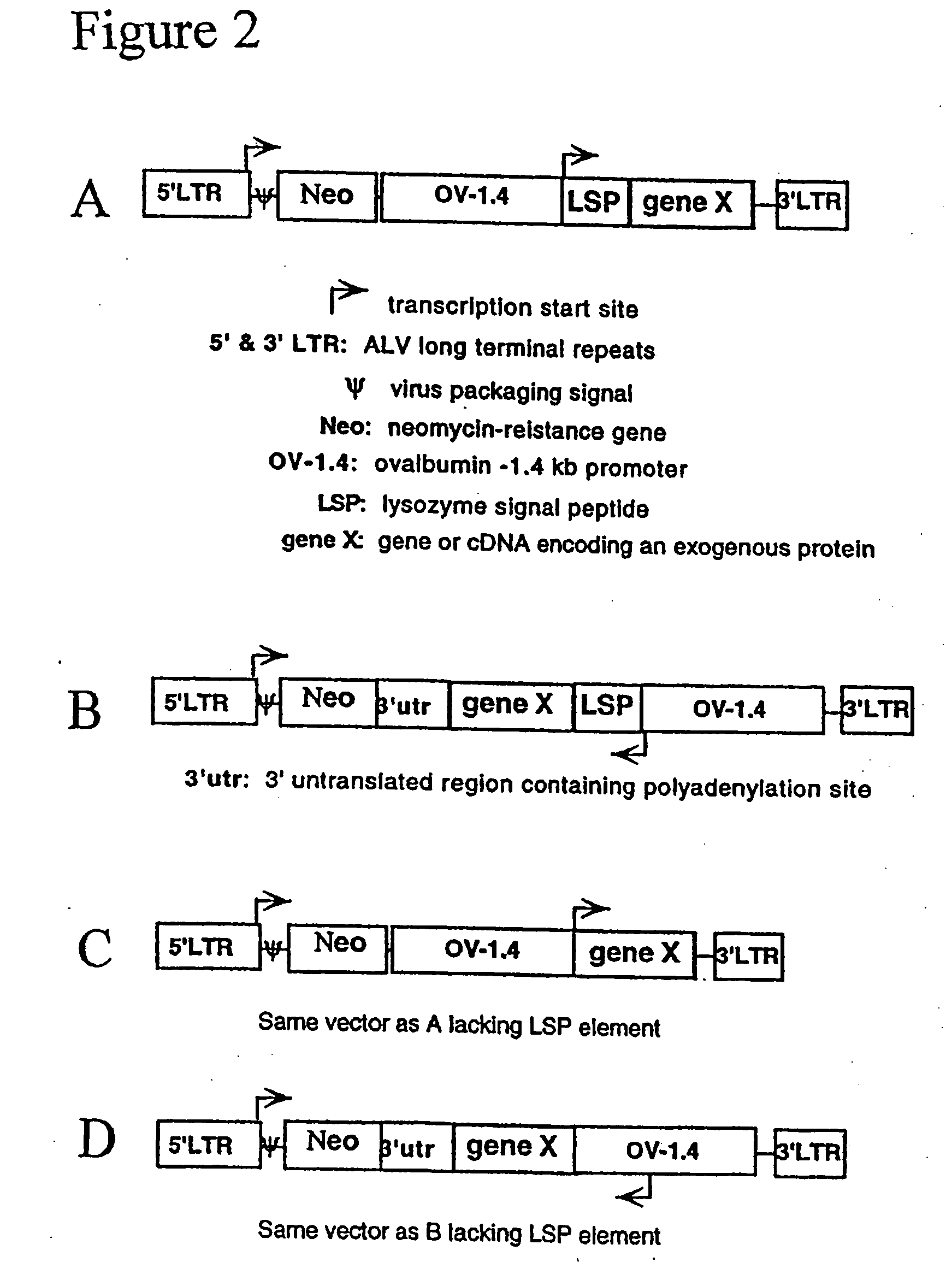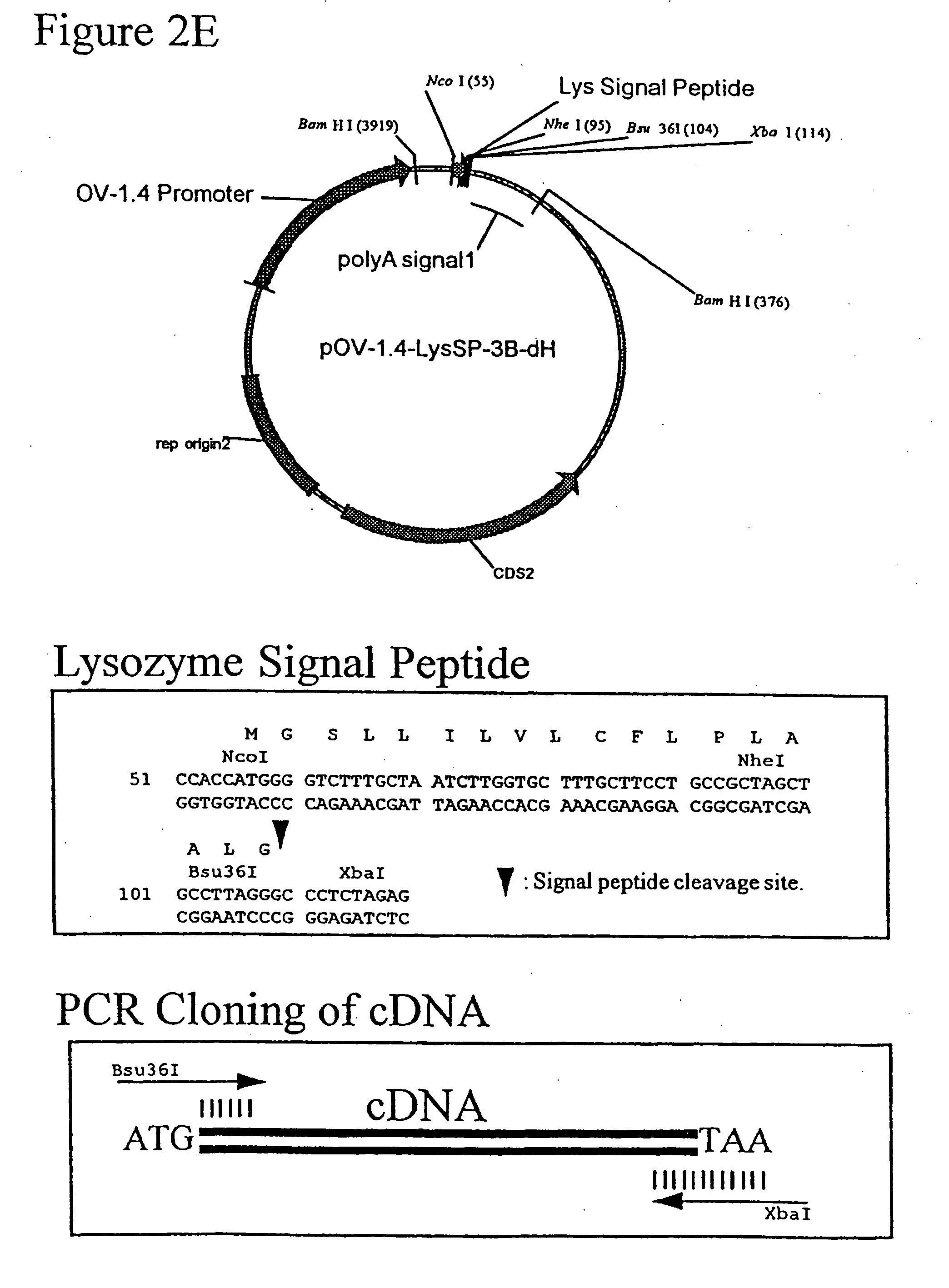Avian eggs and exogenous proteins
a technology of exogenous proteins and eggs, applied in the field of avian eggs and exogenous proteins, can solve the problems of long generation time between founders and transgenic herds, high cost of these methods of protein production, and high cost of these methods, so as to facilitate the production of exogenous proteins, enhance critical avian characteristics, and reduce egg cholesterol
- Summary
- Abstract
- Description
- Claims
- Application Information
AI Technical Summary
Benefits of technology
Problems solved by technology
Method used
Image
Examples
example 1
Vector Construction
[0114] The lacZ gene of pNLB, a replication-deficient avian leukosis virus (ALV)-based vector (Cosset et al., 1991), was replaced with an expression cassette consisting of a cytomegalovirus (CMV) promoter and the reporter gene, β-lactamase (β-La or BL). The pNLB and pNLB-CMV-BL vector constructs are diagrammed in FIGS. 3(a) and 3(b), respectively.
[0115] To efficiently replace the lacZ gene of pNLB with a transgene, an intermediate adaptor plasmid was first created, pNLB-Adapter. pNLB-Adapter was created by inserting the chewed back Apal / Apal fragment of pNLB (Cosset et al., J Virol. 10 65:3388-94 (1991)) (in pNLB, the 5′ ApaI resides 289 bp upstream of lacZ and the 3′ApaI resides 3′ of the 3′ LTR and Gag segments) into the chewed-back KpnI / SacI sites of pBluescriptKS(−). The filled-in MluI / XbaI fragment of pCMV-BL (Moore et al., Anal. Biochem. 247: 203-9 (1997)) was inserted into the chewed-back KpnI / NdeI sites of pNLB-Adapter, replacing lacZ with the CMV promot...
example 2
Production of Transduction Particles
[0116] Sentas and Isoldes were cultured in F10 (Gibco), 5% newborn calf serum (Gibco), 1% chicken serum (Gibco), 50 μg / ml phleomycin (Cayla Laboratories) and 50 μg / ml hygromycin (Sigma). Transduction particles were produced as described in Cosset et al., 1993, herein incorporated by reference, with the following exceptions. Two days after transfection of the retroviral vector pNLB-CMV-BL (from Example 1, above) into 9×105 Sentas, virus was harvested in fresh media for 6-16 hours and filtered. All of the media was used to transduce 3×106 Isoldes in 3 100 mm plates with polybrene added to a final concentration of 4 μg / ml. The following day the media was replaced with media containing 50 μg / ml phleomycin, 50 μg / ml hygromycin and 200 μg / ml G418 (Sigma). After 10-12 days, single G418r colonies were isolated and transferred to 24-well plates. After 7-10 days, titers from each colony were determined by transduction of Sentas followed by G418 selection. ...
example 3
Production of Transgenic Chickens
[0117] Stage X embryos in freshly laid eggs were transduced with NLB-CMV-BL transduction particles (from Example 2, above) as described in Thoraval et al., Transgenic Res. 4:369-377 (1995), herein incorporated by reference, except that the eggshell hole was covered with 1-2 layers of eggshell membrane and, once dry, Duco model cement.
[0118] Approximately 120 White Leghorns were produced by transduction of the stage X embryos with NLB-CMV-BL transduction particles. These birds constitute chimeric founders, not fully transgenic birds. Extensive analysis of DNA in the blood and sperm from the transduced chickens indicates that 10-20% of the birds had detectable levels of the transgene in any given tissue. Of those birds carrying the transgene, approximately 2-15% of the cells in any given tissue were actually transgenic.
PUM
| Property | Measurement | Unit |
|---|---|---|
| concentration | aaaaa | aaaaa |
| sizes | aaaaa | aaaaa |
| concentration | aaaaa | aaaaa |
Abstract
Description
Claims
Application Information
 Login to View More
Login to View More - R&D
- Intellectual Property
- Life Sciences
- Materials
- Tech Scout
- Unparalleled Data Quality
- Higher Quality Content
- 60% Fewer Hallucinations
Browse by: Latest US Patents, China's latest patents, Technical Efficacy Thesaurus, Application Domain, Technology Topic, Popular Technical Reports.
© 2025 PatSnap. All rights reserved.Legal|Privacy policy|Modern Slavery Act Transparency Statement|Sitemap|About US| Contact US: help@patsnap.com



